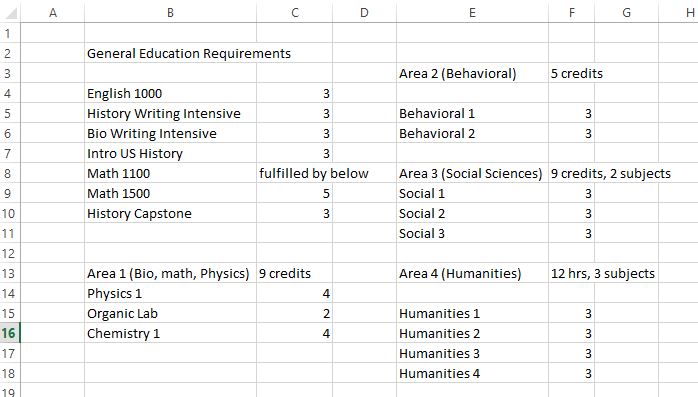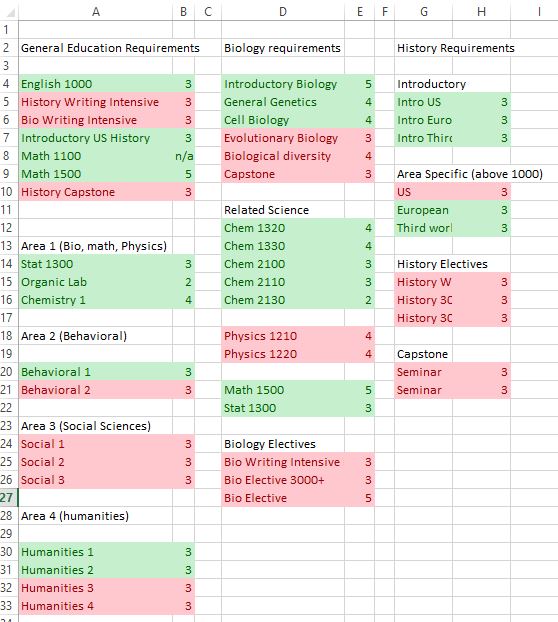One of the best decisions I made in college was charting out my courses with a 4 year plan. College is a journey and every journey requires a roadmap. By mapping out your college journey, you’ll have a clear idea of where you stand and what you have left to do. If you just stick to the recommendations you get from advisors, you’re liable to take classes you don’t need or to take an inefficient route to graduation. I know of multiple people who, due to poor planning, ended up having to extend college by a year. A year might not seem like that much of time in the grand scheme of things, but if you think about where you are right now in life, a year is a massive time investment. Plan your college course wisely.
Contrary to what people may tell you, making a 4 year plan doesn’t lock you in to one college path. I changed majors three times before I graduated but my 4 year plan helped keep me on track to graduate without adding time. If anything, I felt less locked in and more comfortable changing my major because I knew where I stood and how to adjust my courses to not spend extra time in college. I never worried about not finishing on time or missing a requirement because I knew I had already mapped it out on my plan. It also made registration much easier because I knew which categories I still needed to complete.
The best way to show this is by example, so I’m going to walk through a hypothetical student who has graduated from high school with zero AP credits and wants to double major in Biology and History at the University of Missouri.
First thing to do is to find out what the general education requirements for your college are. I just googled “General Education requirements Mizzou” and found this helpful sheet.
All schools will have some type of document or website which similar outline the requirements. Put this into your own Excel spreadsheet.
This is what it looks like right now.
Next, go through and find the specific requirements for the major you’re interested in. Usually this is found on the department website for that major. They make it nice and easy to find because you’ll usually have to fill it out around your junior year to get a grad plan filed. Here it is:
Do the same thing as last time and transfer them to the spreadsheet. Try to be as specific to the requirements as you can (History 3000+ elective, not History class). Write down the estimated credit hours for each class (most are 3 credit hours).
This is what it looks like now.
Now go back and fill out any overlaps in your general education requirement. Here, the Biology major required math and science courses which fulfill general education requirements. In most schools (including this one), classes in the actual major can’t count as general education requirements. So History doesn’t fulfill any social science requirements, meaning our student has to take them all from non-history courses.
Now the first sheet looks like this:
So now, I’ve got all the requirements listed down. Now, I just have to see if I’m short 120 credits and if so, add electives to make them up. See here.
126, not short at all!
Now, go and make a blank 4 year template and paste in the courses. This is what it looks like now:
Realize, this isn’t necessarily which classes I’m going to take every semester. As you sign up for classes each semester, cross off the requirements you’ve completed and shuffle around classes in the other semesters as needed. Knowing your requirements actually gives you more flexibility in planning your classes. If you know you need a Humanities class and you see one that interests you, you don’t have to worry about adding extra time on. Just sign up for that class, paste in “Humanities 1” in to that semester and cross it off from the list of requirements. If you’re handy with Excel, you can color code the cells to turn from red to green as you complete each requirement. Half way through college, your sheet might look like this:
If you have specific requirements (pre-med coursework, honors college requirements, etc) incorporate that into the spreadsheet as well. Basically, this spreadsheet should be able to give you a bird’s eye view of your college education with a single glance. If you’d like, you can set up formulas to dynamically calculate your GPA and science GPA if you’d like. Here’s what mine looked like by the time I graduated (changed the grades, those aren’t what I actually got).
There’s something comforting about seeing your graduation map gradually change from all red to mostly red to mostly green to all green.
And there you have it, how to map our your college career! Definitely one of the best things you can do before you even start college to be on track.
In our next article, we’ll insha’Allah talk about getting into making a good study routine. In the meantime, if you haven’t read the previous articles in this series, check them out here:
The Muslim Man’s Guide to College Part I: Get in the right mindset
The Muslim Man’s Guide to College Part II: Testing out
The Muslim Man’s Guide to College Part III: Choosing a college
The Muslim Man’s Guide to College Part IV: Choosing a major
The Muslim Man’s Guide to College Part V: Mapping your journey
The Muslim Man’s Guide to College Part VI: Creating a calendar
The Muslim Man’s Guide to College Part VII: Going beyond the classroom
The Muslim Man’s Guide to College Part VIII: How to study
The Muslim Man’s Guide to College Part IX: Dealing with failure
The Muslim Man’s Guide to College Part X: To MSA or not to MSA?












Leave a Reply